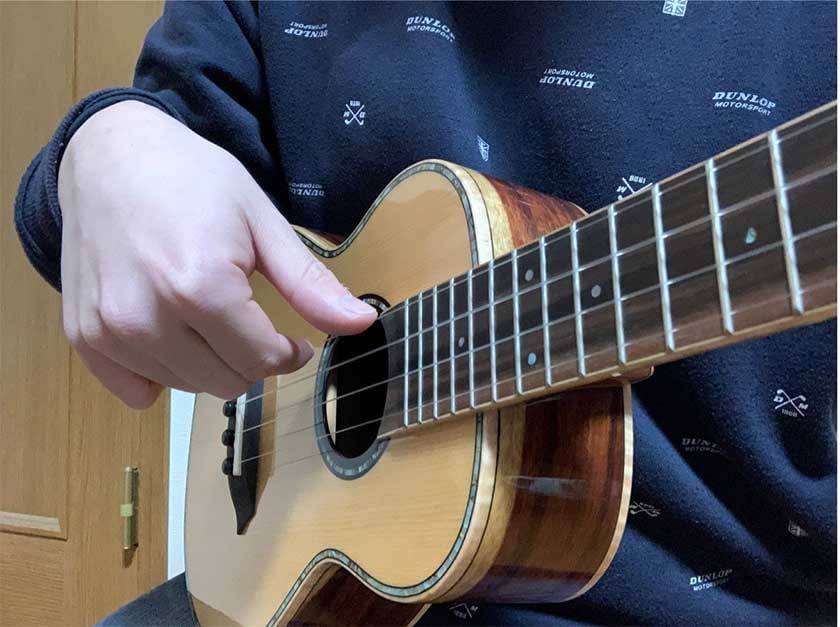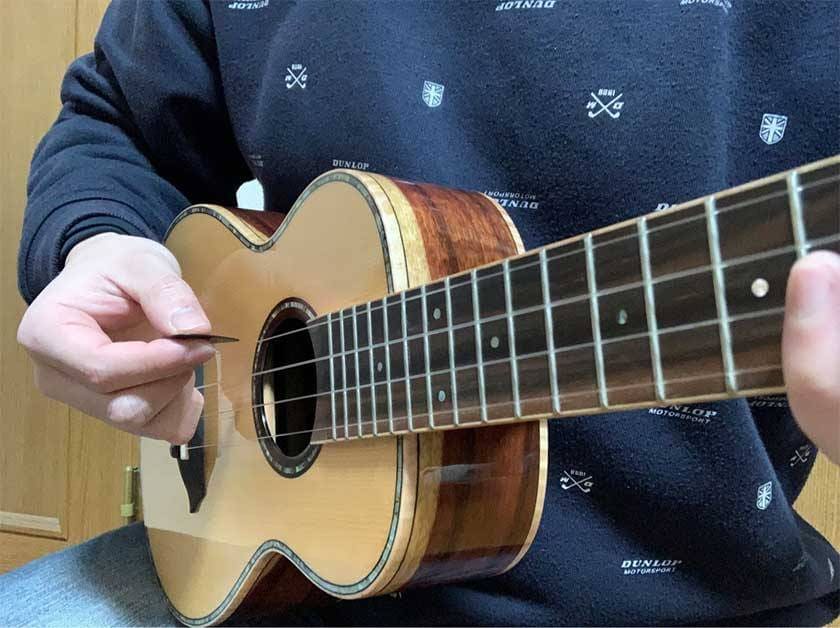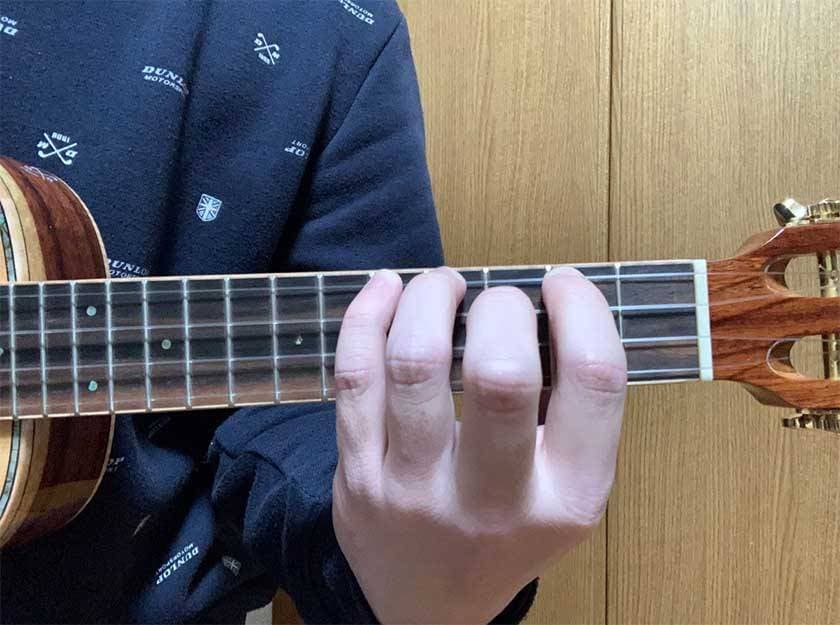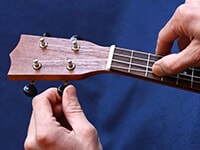Hello, this is Conservario!
Out of the blue, but—are you interested in shredding?
If you've clicked on this column and are reading it, chances are you're curious about playing fast.
To put it super simply, shredding just means “playing fast.”
Anything played quickly qualifies as shredding!
Let me introduce some recommended practice phrases.
Ukulele Shredding
Ukulele shredding can generally be divided into two main styles:
Strumming-based or single-note based.
In this column, we'll focus on single-note shredding.
First, let’s think about the right-hand technique.
There are two common methods, and it’s best to be able to use both.
① Playing with the thumb and index finger
① Playing with a pick
Let’s start by explaining method 1: playing with the thumb and index finger.

You'll only be using the 4th string—don’t play the others.
Alternate between a downstroke with your thumb and an upstroke with your index finger:
Thumb down, index up, thumb down, index up… and so on.
If either your thumb or index finger digs too deep into the string, you won’t be able to play fast.
Keep your strokes light and shallow for speed.
However, if your strokes are too shallow, the sound may become weak and lacking in presence.
Try to find a good balance between volume and playability.
Also, be mindful of any drastic difference in tone between your thumb and index finger—it can sound unnatural.

②Now let’s explain method 2: playing with a pick.
Using a pick to play is called "picking."
When you strike downward, it's called down-picking, and when you strike upward, it's up-picking.
Alternating between down and up strokes is called alternate picking.
With alternate picking, you’ll be playing only the 4th string.
Just like with fingerstyle, if you dig the pick too deep into the string, it’ll slow you down.
Use just the tip of the pick and aim for a smooth, light motion. The key is to use your wrist for the movement.
Some people play by keeping their wrist fixed and moving their elbow, but this method makes it hard to control the finer details—so it’s not recommended.
Once you’ve gotten comfortable with both methods (1 and 2), it’s time to start incorporating the left hand into your practice.

Just like before, we’ll be using only the 4th string for this phrase.
You might recognize a similar melody from the old opening theme of a certain cat-robot anime—nostalgic, right?
For the left hand, you’ll be using your index finger, ring finger, and pinky.
Press down on the 2nd fret with your index finger, the 4th fret with your ring finger, and the 5th fret with your pinky.
At first, focus on playing slowly and cleanly—really take your time.
It’s totally understandable to want to play fast right away, but don’t rush it!
But if you force yourself to play fast too soon, both your right and left hands—and your sound—will end up a mess.
And if you keep practicing messy shredding, it’ll just stay messy.
There won’t be a magical day when your playing suddenly becomes clean and perfect.
Now, if you say, “This wild and chaotic style is just my personal flair!”—
well, in that case, I won’t argue…
It’s likely to hold you back in your ukulele journey down the line, so personally, I don’t recommend that approach.
Start slow, and once you’ve gotten used to it, gradually increase the tempo.
There’s also something very important about left-hand movement:
Make sure your left hand doesn’t move more than necessary.
For example, when you're playing with your pinky, keep your other fingers resting on the frets—they should stay close and ready.

You’ll notice this when you try it: when your pinky is pressing down on the 5th fret, whether your index or ring finger is also pressing a fret or not doesn't change the sound at all.
So you might think, “Then it’s fine if they’re not touching, right?”
But no—keep them pressed down.
There’s a reason for it. By keeping your fingers in place, you can simply lift them one by one—pinky, ring, then index—and you'll be able to play the first part of the phrase smoothly.
If your fingers are floating, you’ll need to press down each time, which slows you down and makes fast playing harder.
Shredding practice isn’t just for shredding—it’s also a great opportunity to rethink your everyday finger technique.
So definitely try incorporating it into your regular practice routine.
Once you’re comfortable playing phrases on the 4th string using your index, ring, and pinky, it’s time to move on to the next phrase.

This time, we’ll use a phrase on the 1st string, played with the index, middle, and pinky fingers.
Press the 2nd fret with your index finger, the 3rd fret with your middle finger, and the 5th fret with your pinky.
Just like before, keep your left-hand movements minimal and play slowly and carefully.
While we’ve been focusing a lot on the left hand, the right hand is just as important—if not more so.
For those playing with the thumb and index finger—
Are you alternating properly?
Be careful not to hit the string twice in a row with your thumb.
For those using a pick—
Practice with just downstrokes, just upstrokes, and with alternate picking.
Make sure not to dig in too deep—use only the tip of the pick for a light, clean touch.
Summary
We’ve introduced some recommended practice phrases for shredding.
To be honest, if simply reading this column and playing a little bit were enough to master shredding, no one would struggle with it.
You don’t see it as often with the ukulele, but in the guitar world, there are countless instructional books and YouTube videos dedicated solely to fast playing.
Maybe that just shows how much demand there is for shredding in the guitar world—but ukulele and guitar are different instruments.
So here’s something important for anyone starting to practice shredding on the ukulele:
Shredding is just one of many techniques.
It’s not something you must be able to do, nor is it something every song needs to include.
But if there’s a fast section in a song you’re working on and you just can’t quite nail it, try practicing the shredding phrases from this column—they might help.
I hope you found this helpful.
Thank you for reading all the way to the end!
The “sound & person” column is made up of contributions from you.
For details about contributing, click here.











![[Enjoy the Ukulele Even More!] How to Simplify Chords](/contents/uploads/thumbs/5/2022/1/20220120_5_16255_1.jpg)
![[Enjoy the Ukulele Even More!] What is a Chord in the First Place?](/contents/uploads/thumbs/5/2022/1/20220110_5_16098_1.jpg)
![[Enjoy Your Ukulele Even More!] Play Stylishly with Arpeggios](/contents/uploads/thumbs/5/2022/1/20220110_5_16096_1.jpg)
![[Enjoy the Ukulele Even More!] What Exactly is a Scale?](/contents/uploads/thumbs/5/2022/1/20220107_5_16092_1.jpg)
![[Enjoy the Ukulele Even More!] Easy Way to Play Strokes With Your Thumb](/contents/uploads/thumbs/5/2021/12/20211230_5_15998_1.jpg)
![[Enjoy the Ukulele Even More!] Tips for Playing Your Own Accompaniment](/contents/uploads/thumbs/5/2021/12/20211230_5_15993_1.jpg)
 ウクレレのチューニング方法
ウクレレのチューニング方法
 DIY ギターメンテナンス
DIY ギターメンテナンス
 ウクレレの各部名称
ウクレレの各部名称
 ウクレレの種類
ウクレレの種類
 ウクレレスタートガイド
ウクレレスタートガイド
 ウクレレ初心者講座
ウクレレ初心者講座















